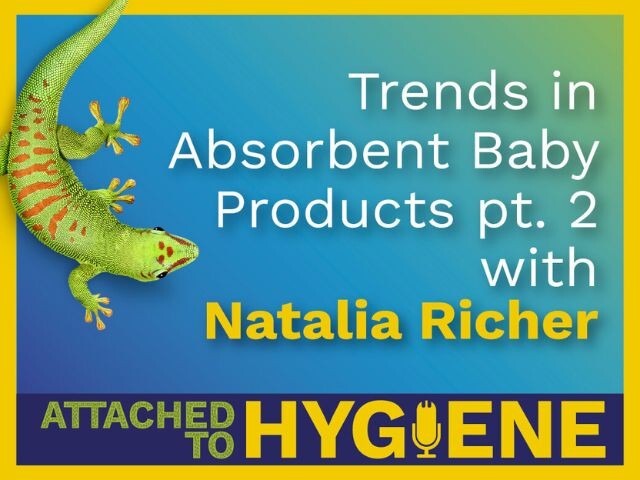Jan 16, 2023 - 3 minutes
Trends in Absorbent Baby Products pt. 2 with Natalia Richer

On Episode 45, we continue our conversation with Natalia Richer as she shares more insights on the latest trends in baby diapers and pants, how sustainability is impacting the market, and where she thinks the future of absorbent baby products lies.
When it comes to staying current on global trends in the absorbent hygiene industry, Natalia Richer has an enviable position. As COO of Diaper Testing International (DTI), she sees what companies around the world are working on and what consumers are purchasing. Fortunately, Natalia is glad to share her insights with ‘Attached to Hygiene’ listeners. In Part 2 of her conversation with host Jack Hughes, their discussion includes additional trends and hopes for the future of baby diapers.
Consumers, safety, and sustainable materials
The current movement toward greener absorbent hygiene products is undeniable. New brands are appearing, and a segment of the consumer base is embracing them. However, parents’ reasons may vary. Certainly many parents value sustainability, but a large portion list safety as their primary motivation. These parents equate natural materials with safer, more gentle experiences for their babies.
The shift toward thinner diapers, channel cores, and pre-compound cores
From all that DTI has seen, the slow evolution toward thinner products continues unabated. Newer core designs like channel and pre-compound cores are proving their value and their use is spreading. Pre-compound cores in particular are lowering entry barriers for start-ups. By purchasing cores instead of building them, these emerging brands avoid certain equipment costs and production headaches.
This may be one reason more smaller players, including D2C (Direct to Consumer) brands, are reaching the market. Current estimates place smaller brands at about 2% of sales. Natalia noted that most are focusing their advertising efforts at competing with other brands in the same niche, rather than targeting customers of the larger brands.
Predictions and hopes for the future of baby diapers
Elastics and pant diapers are two of the industry’s biggest trends and both are expected to continue. Each of them offers advantages to consumers and babies alike. Prominent among the benefits are convenience, comfort, fit, and performance. The shift toward more eco-friendly practices is likely to continue as well. However, until the industry makes headway in finding viable end-of-life options, companies will focus on the production side and more sustainable ingredients.
Natalia also shared a hope for the future. She looks to the industry to begin more differentiation in products based on their target use. One example would be diapers specifically designed for daytime vs. night-time wear. Another would be more variation between smaller and larger sizes to reflect changes in a growing baby’s behaviour patterns.
Outline of the Episode
- [1:28] Continuing evolution toward thinner products and new core designs
- [4:10] Premade cores lower the entry barriers for small brands
- [9:45] The focus on safety and sustainable materials
- [14:57] What product reviews say about consumer reasons for buying eco-friendly diapers
- [21:27] Consumer testing surprises: US consumers are more open to wider chassis diapers than expected
- [23:59] Predictions and hopes for the future of baby diapers
Resources
Connect with Natalia Richer at via LinkedIn.
Follow with DTI (Diaper Testing International) on LinkedIn.
Get Connected with Attached to Hygiene
Subscribe to “Attached to Hygiene” and never miss an episode!
You can email us with questions, comments, or ideas for future episodes at [email protected].
Host: Jack Hughes
Music by Jonathan Boyle
Produced and edited by: Jack Hughes with help from Paul Andrews, Michele Tonkovitz, Emory Churness, Nikki Ackerman, and Green Onion Creative.
See also
Back to all articles- Disposable Hygiene
India, Africa, Latin America: Key Growth Regions for Period Care Products
- Disposable Hygiene
Evaluating Baby Products to Earn Parents' Trust pt. 1 with Sharon Vinderine
- Disposable Hygiene
